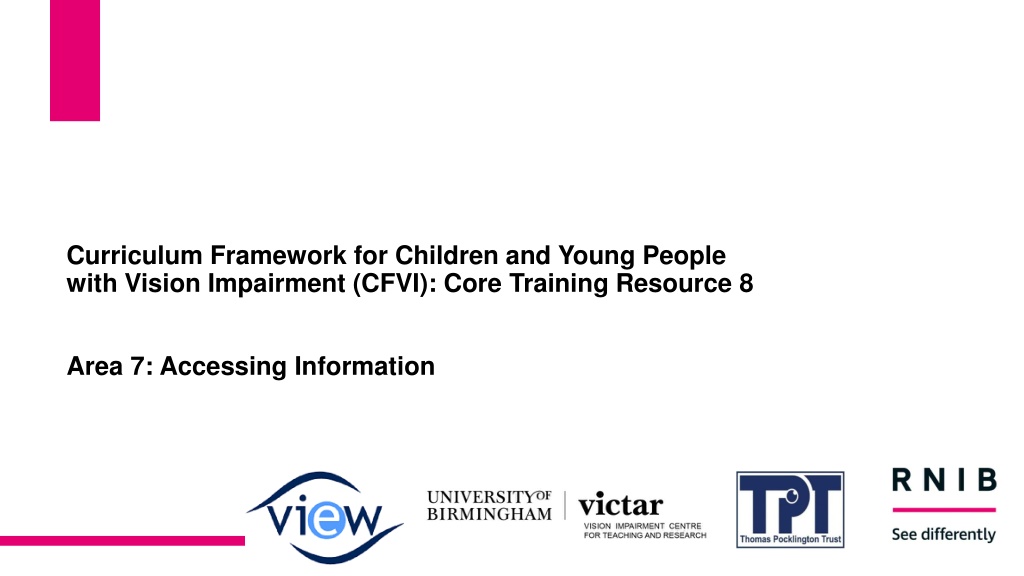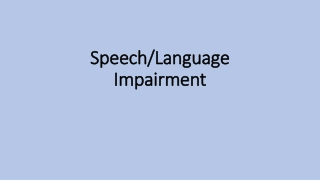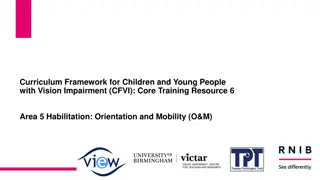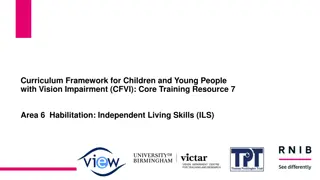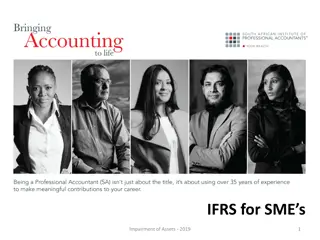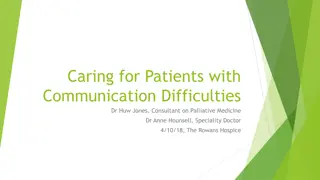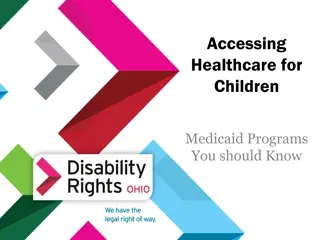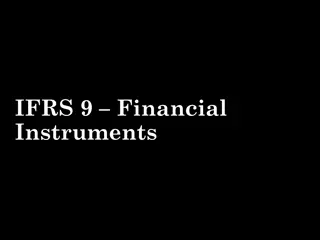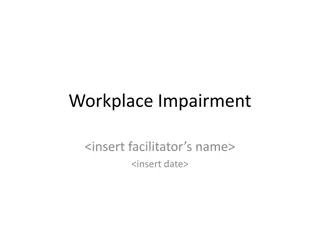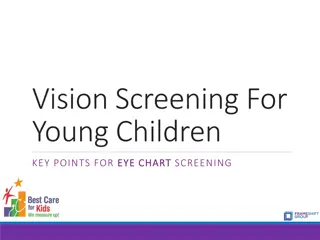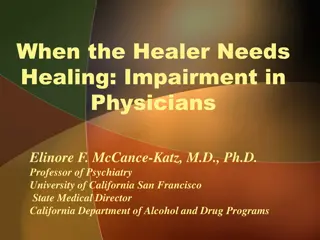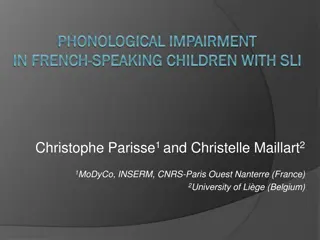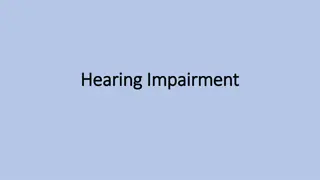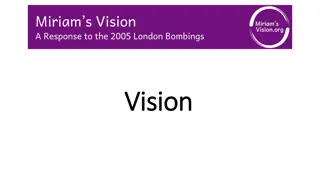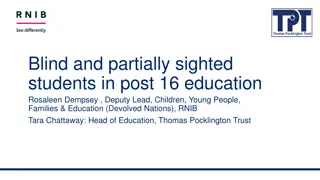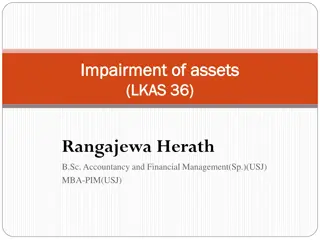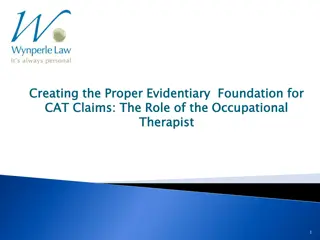Accessing Information for Children with Vision Impairment
Explore the Curriculum Framework for Children and Young People with Vision Impairment (CFVI) training resource focusing on accessing information, including barriers, intervention approaches, and specialist adjustments. Learn about the importance of teaching methods for independence and skills development in managing information-rich environments.
Download Presentation

Please find below an Image/Link to download the presentation.
The content on the website is provided AS IS for your information and personal use only. It may not be sold, licensed, or shared on other websites without obtaining consent from the author. Download presentation by click this link. If you encounter any issues during the download, it is possible that the publisher has removed the file from their server.
E N D
Presentation Transcript
Curriculum Framework for Children and Young People with Vision Impairment (CFVI): Core Training Resource 8 Area 7: Accessing Information
Project Partners There are 4 partner organisations involved in the CFVI project. The production of these training/continuing professional development materials was led by VIEW (The Professional Association for the Vision Impairment Education Workforce), in association with a consultation group of stakeholders working in the field of VI Education.
Curriculum Framework for Children and Young People with Vision Impairment (2022, p.15)
Training Objectives (1) The objectives of this training resource are to: Provide an introduction to Area 7 of the CFVI: Accessing Information. Explore examples of potential barriers to facilitating inclusion for learners with vision impairment and targeted intervention approaches we can draw upon to help reduce these. Examine why a focus on this area is important for learners with vision impairment. Outline a range of specialist adjustments and teaching approaches. Provide links to useful resources/websites.
Training Objectives (2) Customisable slide if needed (see notes for the previous slide which give examples of training objectives that you could consider, depending on the nature of your presentation).
About this area: Accessing Information This area of the framework considers the teaching of methods children and young people can use to access, manage and produce information as independently as possible. As well as a range of skills, young people require an understanding of the following: when to use particular approaches, how to manage and navigate an information rich world, and the role of others in scaffolding them by preparing materials, adjusting the environment and making accommodations.
Identifying potential barriers to access (1) Situation What does vision tell the child in this situation? the task it s content the layout of the worksheet what additional equipment is needed measurements on the ruler (secondary) A pupil without a VI accessing a worksheet (font size 14) which includes diagrams of 2D shapes. At primary level the task is to: write about the properties of the 2D shapes shown as diagrams: shape on left and lines on which to give answer to the right. The pupil will also be able to follow quickly the teacher s explanation as they pinpoint areas of the sheet to look at. This may be by looking at the printed sheet or the sheet presented on an interactive whiteboard. At secondary level the task is to work out the perimeter of a polygon, such as a heptagon, and will require measurements with a ruler.
Identifying potential barriers to access (2) Situation Inclusive strategies to reduce barriers to access ? A child/young person with severe VI: they can access font size 24 (Bold) with 1.5 line spacing. Their distance vision is 6/60. The secondary pupil cannot access mm readings on a ruler.
Identifying potential barriers to access (3) Situation Inclusive strategies to reduce barriers to access ? ? ? Add here Add here
Why a focus on this area is important Children and young people with a VI will have reduced access to information produced in standard formats. They may need intervention to learn strategies to organise information, to use technology to access information and to produce information independently in a format they can access/read back. Accessing information is key to enabling children/young people to fully participate in all areas of education and the wider world alongside their peers. In education, it is an important factor in promoting achievement and progress that is commensurate with the underlying cognitive ability of the pupil/student. It also has a role to play in social interaction. So .reduced vision will require interventions to ensure an appropriate access to information is secured.
Why a focus on this area is important for (name of child/young person); what interventions are in place? Accessing information is key to (name of child) being able to fully participate in class alongside their peers. Individual support will be informed by: Details of pupil s vision impairment. How it influences their access to the curriculum/social interactions. What interventions are in place to promote sensory development? What are the envisaged outcomes? Who delivers/works on these outcomes?
Examples of targeted intervention approaches for Area 7 listed in CFVI to reduce barriers (1) Understanding and developing a range of suitable approaches to accessing and presenting information (e.g. tangible objects/objects of reference, print, speech, recordings, braille, tactile graphics). Recognise that taught strategies to accessing information will change, and this may be linked to developmental stage or changing circumstances (e.g. in relation to level of vision, or child or young person s views). Choosing suitable approaches (or combinations of approaches) to accessing and presenting information in different circumstances. This should include low-tech solutions to provide alternative options when technologies fail. Managing information so that it can be accessed when needed (e.g. contacts, timetables, diaries).
Examples of targeted intervention approaches for Area 7 listed in CFVI to reduce barriers (2) Supporting the development of key concepts around numeracy and data at an appropriate age or stage of development, including (where appropriate) supporting understanding of braille codes and language relating to the key concepts both in maths and science. Supporting the development of tactile graphicacy skills to promote and facilitate access to two and three-dimensional representational material such as tactile maps, diagrams, pictures and other graphical and figurative material. Supporting ability to choose specific approaches (or combinations of approaches) to information access in particular contexts (e.g. exam skills, in lessons and independent study).
Examples of targeted intervention approaches for Area 7 listed in CFVI to reduce barriers (3) Managing information, for example file/folder management, organisational skills, editing/bookmarking, revision skills. This includes teaching specific study skills for students accessing information in non-visual ways. Learning to use, recognise and manage the tools needed to access information (e.g. low vision devices, technology, software and hardware). Understanding the wider systems required to access information: when to seek support, when to seek accommodations, being aware of entitlements
Summing up Vision impairment creates distinctive barriers to access, learning and participation for children and young people. Targeted intervention approaches within inclusive learning environments (See CFVI, Area 1) are required, alongside interventions focussing on accessing information. Collaborative working with the child/young person, family and educators is required to maximise access to information.
What resources are available The Bookshare Hub hosting resources to support the delivery of the CFVI is available from the RNIB (External) Of particular relevance to this area is the Accessing Information category of the CFVI Resource Hub RNIB Bookshare has an extensive range of textbooks/works of literature in accessible formats The CFVI provides a list of targeted intervention approaches (pages 26 and 27): Curriculum Framework for Children and Young People with Vision Impairment | RNIB
References Hewett, R., Douglas, G., McLinden, M., James, L., Brydon, G., Chattaway, T.,Cobb, R., Keil, S., Raisanen, S., Sutherland, C., Taylor, J., (2022) Curriculum Framework for Children and young People with Vision Impairment[CFVI]: Defining specialist skills development and best practice support to promote equity, inclusion and personal agency. RNIB
